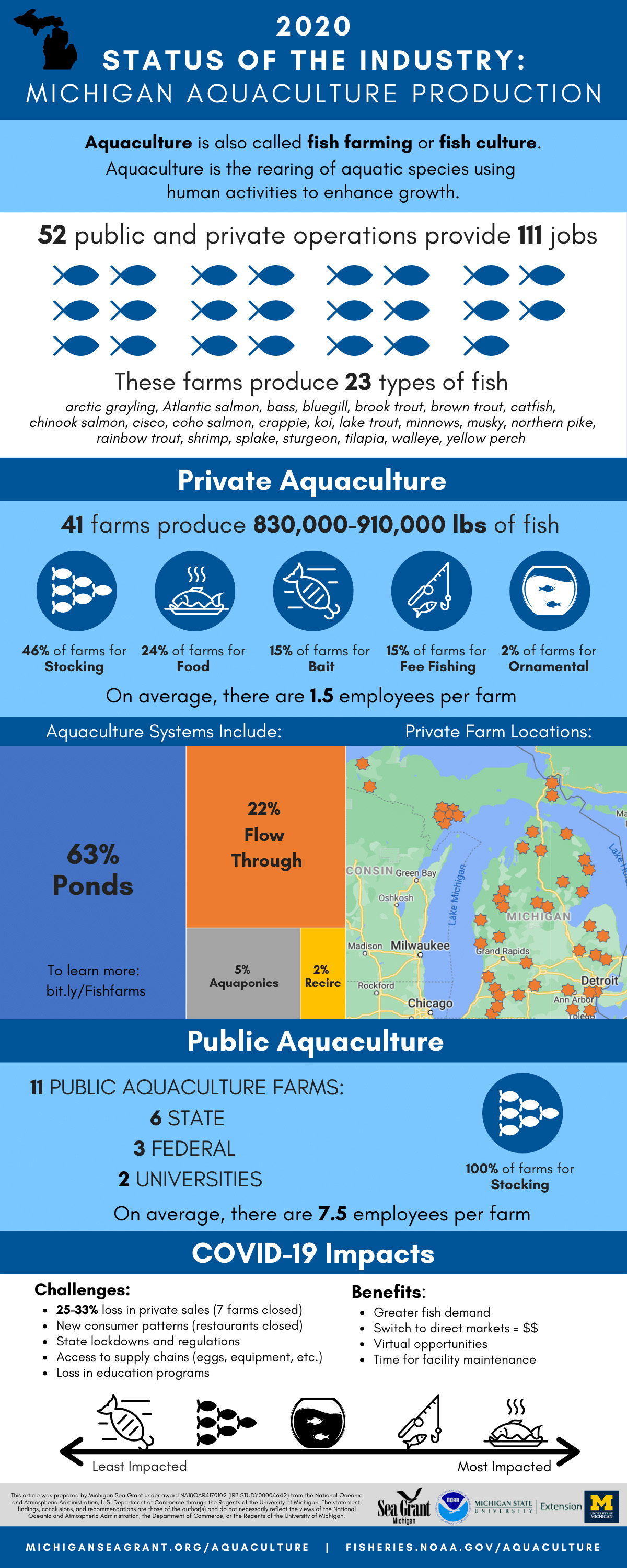2020 Status of the Industry: Michigan Aquaculture
What does aquaculture look like in Michigan and how did COVID-19 impact the industry in 2020?

Aquaculture, also called fish farming or fish culture, is defined as the rearing of aquatic species using human activities to enhance growth. In Michigan, there are a variety of types of fish farms that are owned by private businesses, state or federal agencies, tribal entities, and nonprofits. Schools and nonprofits also use aquaculture to support research, education, and outreach. Fish are grown for a wide variety of purposes from stocking public waters to supplying food for local families. The aquaculture industry provides jobs, food security, and a sustainable protein source, and is a relatively small, but important part of Michigan’s economy.
The COVID-19 pandemic caused many changes to the aquaculture industry and to fully understand the impact it has been important to acquire additional information and documentation on the industry to address its needs. While the industry operates under state permits, the information gathered is limited and doesn’t give a full data picture. Understanding how many farms are active, what is grown, and what type of aquaculture systems are used is key to helping to assess economic impacts and industry needs. To help address these challenges, and gather more formal baseline industry data, Michigan Sea Grant received a $100,000 COVID-19 rapid response grant from the National Sea Grant Office. This grant aimed to help assess the aquaculture industry status and impacts from COVID, as well as those of the commercial fishing, and charter fishing industries in Michigan. Needs assessments have provided valuable information on all three industries. In this article, we share a summary of the assessment of the aquaculture industry in 2020. The infographic shown on the status of the industry is also available full size online.
Aquaculture industry status
In 2020, Michigan had 52 aquaculture operations which provided 111 jobs. These businesses produce 23 different types of fish for various purposes with the most common reasons being stocking and food consumption. However other farms produce fish for agritourism (fee fishing), ornamental and aquarium fish, bait fish production, and/or research purposes.Although hatcheries commonly come to mind when discussing aquaculture in Michigan, more than 60% of farms use ponds to grow fish compared to 22% who use flow-through systems, or raceways (to learn more about the different system types of aquaculture visit http://bit.ly/Fishfarms). Of the 52 farms, 11 are public and 41 are privately owned. The public sector includes six state, three federal, and two universities which produce fish for stocking and/or research purposes only. The private sector produces anywhere from 830,000 to 910,000 lbs of fish, mainly rainbow trout. Tribal Nations also own and operate six facilities for mostly stocking and food purposes.
COVID-19 impacts
Michigan’s aquaculture industry was negatively impacted in 2020 due to the pandemic. Uncertainty and state of Michigan orders which included restrictions for restaurants and other food service establishments disrupted food supply chains as well as limited opportunities for local tourism activities. Private businesses experienced loss of sales between 25-33%, and consequently some farms could not afford to remain active. Food fish were the most impacted as disruptions in the food supply chains such as processor and restaurant closures affected businesses. Farmers found they had to rapidly pivot their sales strategies to include direct-to-consumer marketing.
However, there were also some benefits realized from the circumstances. For example, once Michigan reopened, there was a large demand for fish products so sales boomed. Those who did shift from wholesale to retail markets made more money with fewer fish. Some businesses who had the financial capacity were able to take advantage of the time to make facility improvements. The public sector also benefited from the increased online communications which helped to connect them to the various facilities located across the state.
In December 2020, Cares Act Funding allocated $15M to Great Lakes fisheries. This financial assistance will support Great Lakes aquaculture, commercial fishing, charter fishing, and seafood processors. Allocations of Cares Act funding are yet to be determined, but these findings have been reported to decision makers to help in determining allocations and supporting these industries moving forward. Michigan Sea Grant will continue to work with the aquaculture, commercial fishing, and charter fishing industries, as well as, recreational fishers, as part of our mission to foster economic growth and protect Michigan’s coastal, Great Lakes resources through education, research, and outreach.
Michigan Sea Grant is a collaborative effort of the University of Michigan and Michigan State University and its MSU Extension, Michigan Sea Grant is part of the NOAA-National Sea Grant network of 34 university-based programs. This article was prepared by Extension educator Lauren N. Jescovitch and Elliot Nelson under award NA18OAR4170102 (IRB STUDY00004642) from the National Oceanic and Atmospheric Administration, U.S. Department of Commerce through the Regents of the University of Michigan. The statements, findings, conclusions, and recommendations are those of the author(s) and do not necessarily reflect the views of the National Oceanic and Atmospheric Administration, the Department of Commerce, or the Regents of the University of Michigan.



 Print
Print Email
Email

